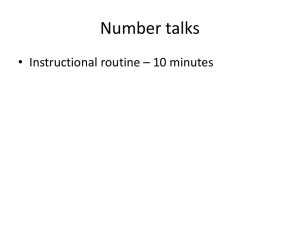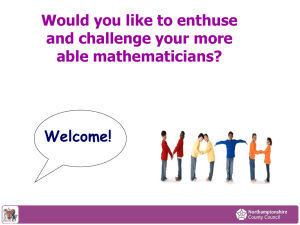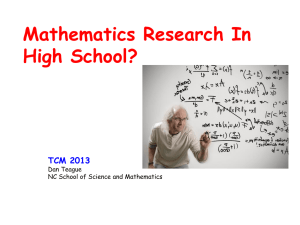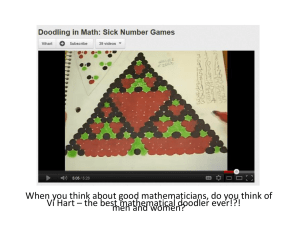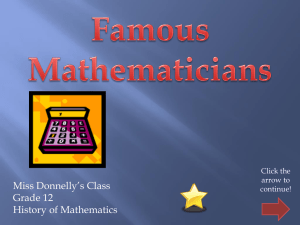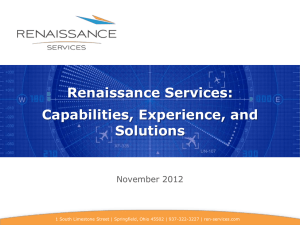Mathematics at The Aerospace Corporation
advertisement
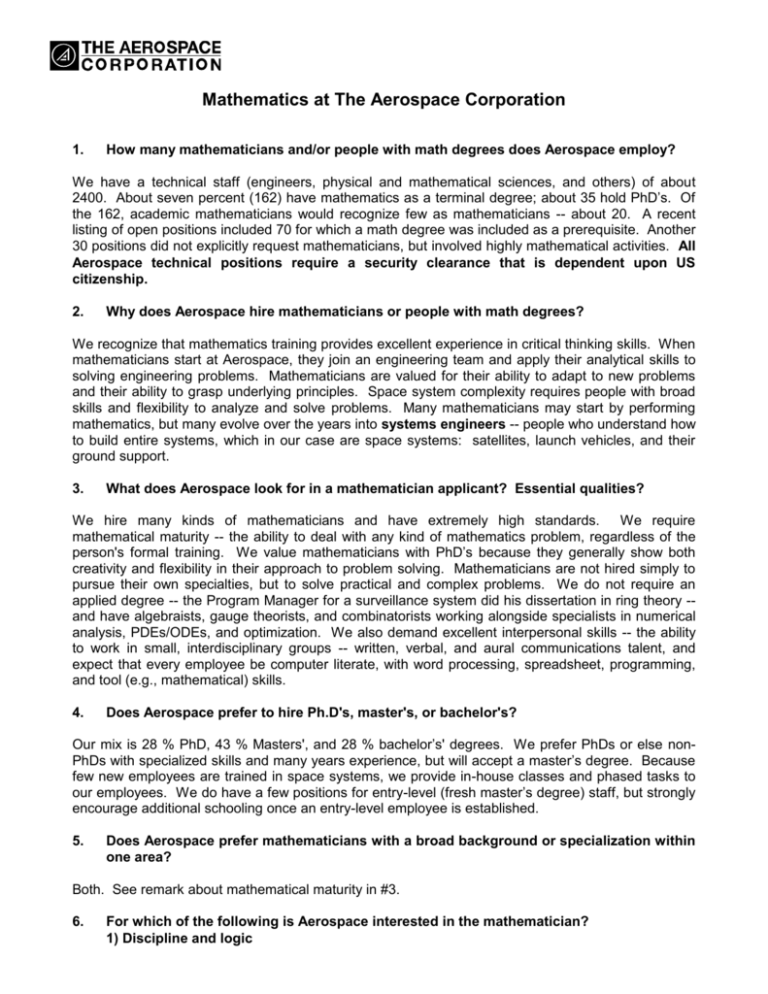
Mathematics at The Aerospace Corporation 1. How many mathematicians and/or people with math degrees does Aerospace employ? We have a technical staff (engineers, physical and mathematical sciences, and others) of about 2400. About seven percent (162) have mathematics as a terminal degree; about 35 hold PhD’s. Of the 162, academic mathematicians would recognize few as mathematicians -- about 20. A recent listing of open positions included 70 for which a math degree was included as a prerequisite. Another 30 positions did not explicitly request mathematicians, but involved highly mathematical activities. All Aerospace technical positions require a security clearance that is dependent upon US citizenship. 2. Why does Aerospace hire mathematicians or people with math degrees? We recognize that mathematics training provides excellent experience in critical thinking skills. When mathematicians start at Aerospace, they join an engineering team and apply their analytical skills to solving engineering problems. Mathematicians are valued for their ability to adapt to new problems and their ability to grasp underlying principles. Space system complexity requires people with broad skills and flexibility to analyze and solve problems. Many mathematicians may start by performing mathematics, but many evolve over the years into systems engineers -- people who understand how to build entire systems, which in our case are space systems: satellites, launch vehicles, and their ground support. 3. What does Aerospace look for in a mathematician applicant? Essential qualities? We hire many kinds of mathematicians and have extremely high standards. We require mathematical maturity -- the ability to deal with any kind of mathematics problem, regardless of the person's formal training. We value mathematicians with PhD’s because they generally show both creativity and flexibility in their approach to problem solving. Mathematicians are not hired simply to pursue their own specialties, but to solve practical and complex problems. We do not require an applied degree -- the Program Manager for a surveillance system did his dissertation in ring theory -and have algebraists, gauge theorists, and combinatorists working alongside specialists in numerical analysis, PDEs/ODEs, and optimization. We also demand excellent interpersonal skills -- the ability to work in small, interdisciplinary groups -- written, verbal, and aural communications talent, and expect that every employee be computer literate, with word processing, spreadsheet, programming, and tool (e.g., mathematical) skills. 4. Does Aerospace prefer to hire Ph.D's, master's, or bachelor's? Our mix is 28 % PhD, 43 % Masters', and 28 % bachelor’s' degrees. We prefer PhDs or else nonPhDs with specialized skills and many years experience, but will accept a master’s degree. Because few new employees are trained in space systems, we provide in-house classes and phased tasks to our employees. We do have a few positions for entry-level (fresh master’s degree) staff, but strongly encourage additional schooling once an entry-level employee is established. 5. Does Aerospace prefer mathematicians with a broad background or specialization within one area? Both. See remark about mathematical maturity in #3. 6. For which of the following is Aerospace interested in the mathematician? 1) Discipline and logic 2) Ability to recognize a mathematical problem in a real-world situation 3) Analytic skills All of the above, but in the order 2, 3, 1. In addition to recognizing the problem in a real-world situation, we expect a solution! 7. Has Aerospace hired mathematicians or people with math degrees for reasons other than using mathematics directly? Certainly. A mathematical background is tremendously helpful, since many of the engineering problems to be solved require mathematical sophistication. As Aerospace employees, mathematicians cannot simply stop with a proof that a solution exists. They may be asked to develop a partial solution within an hour or two. Oftentimes, they must also develop the necessary software needed to implement a practical solution in an efficient and timely manner. They must be able to communicate their results clearly and succinctly to a customer who may not have a great deal of mathematical sophistication, is not interested in how the solution was developed, only in its cost and schedule impacts, and has little time or patience for a complete presentation. 8. Do the mathematicians at Aerospace work more as a separate entity or within groups of some other discipline? Although there are clusters of mathematicians, there is no Mathematics Department. For example, the Navigation and Geopositioning Systems Department, responsible for estimation theory related to positioning applications, has mathematicians for 60 % of its staff. It is hard to tell on the surface who is a mathematician and who is an engineer or physical scientist. Generally, we look for mathematicians who can adapt their research skills to applied disciplines. 9. Do the mathematicians at Aerospace conduct research or serve more as a consultant to other group members? Aerospace is structured into two generic organizations: program offices and support departments. Employees in program offices are devoted to a single space system -- Delta launch vehicles or GPS satellites, for instance. Support staff members are organized by technical discipline -- radar, controls, or navigation. There is no mathematics department. As program offices require specialized skills, they contract for services from the support departments. In this respect, mathematicians consult. There are only a few Aerospace employees who perform mathematical research as the academic community recognizes it. On the other hand, many people develop concepts requiring the same talents as formal research demands, but their focus is on solving a particular class of problems. It is not the research per se, but their expertise that is sought out by others. Excellent mathematicians recognize the elegant mathematics behind the solutions and generalize. 10. Do mathematicians need to be retrained to adjust to Aerospace activities? Certainly -- How many academic mathematics departments know how to build a satellite? More important, there is a culture here at Aerospace (and in industry in general) that must be absorbed. We cannot have mathematicians or chemists or computer scientists who live in isolation and work pure problems within their domains. Instead, we must understand how everything is connected. A numerical integrator used within a launch vehicle guidance algorithm must not only pass all the tests (stability, convergence, truncation, ...), it must also be packaged in such a way that it will be robust under a wide variety of initial conditions. Further, it must be presented to the customer as an efficient and cost-effective method worthy of consideration in light of competition from other algorithms that have been used for years and years. The integrator must be tolerant of other vehicle systems which may not know exactly what time it is, which way is up, or where the vehicle is. Heady stuff! 11. What are the strengths and weaknesses of mathematicians in contributing to Aerospace? Mathematicians frequently provide fresh and innovative approaches to complex and unusual problems. Mathematicians provide a sanity check on the assumptions that engineers make. 99 % of the time, the assumptions are right, but one chance in a hundred with a billion dollar satellite is one chance too many. Mathematicians may also think in a manner orthogonal to those of other academic persuasions. Some employees (mathematicians included) never make it off the ground following their hire because they cannot relate their (academic) skills to the reality of the workplace. We see employment application after employment application in which the applicant offers us the opportunity to support his/her research in some discipline. Sorry -- when you work for Aerospace, you have to solve Aerospace problems. If you can find a research-level topic hidden in more mundane work, you can often find support for a limited time in an investigation to extend your result past its initial use for future application. In the end, Aerospace shares a limited military budget and cannot expend effort on tasks that do not advance its clients’ needs. 12. What are the opportunities for mathematicians or people with math degrees at Aerospace? Because of our profession's focused reputation: Here's to Uncle Albert E Pundit of relativity You'll know him by his shaggy locks And by his utter lack of socks! mathematicians start work at a disadvantage. As problems get harder and harder (the world is not linear!), they are being appreciated more and more. The recognition process is two-way. The company must recognize the excellence of the results mathematicians produce and the mathematician must understand what the company desires. For these reasons, Aerospace takes great care in placing mathematicians into the right internal organizations to achieve their greatest potential. 13. What areas of mathematics are applicable to Aerospace activities? Our prime areas are applied disciplines: numerical analysis, probability and statistics (assuming this is accepted as mathematics), applied linear algebra, optimization, and discrete mathematics (filter and coding theory). We also do a bit of harmonic analysis (signal processing), combinatorics, and differential equations. Be warned that mathematics at Aerospace is practiced by a lot of people, many of whom are not mathematicians. Some of our best mathematicians are engineers and some of our best engineers are mathematicians. 14. What kind of mathematical problems does your company face? Just about every kind of applied problem. This includes practically every technique in numerical analysis, from linear algebra to numerical solution of initial value problems to least squares; computational geometry (Voronoi cells); optimization (non-linear with constraints); harmonic analysis (signal processing) -- the list seems endless. We deal with both continuous and discrete mathematics. Consider the problem of a satellite tasked to look at a large number of ground targets. It must find as many targets as possible. Each target has a importance score, different viewing geometries with each satellite fly-by, and different update requirements (once per day, once per week,...). Steering the satellite sensor adds to the problem complexity, as does the time the sensor must spend pointed at the target. This is a combinatorial optimization problem worthy of study. Clustering theory plays a role in signal processing and logic is applied to computer security applications. We must deal with solutions known to be partially correct. Oftentimes, a client will request an answer within an hour and is willing to accept incomplete answers under time pressure. 15. At what stages of the product cycle is mathematics used most frequently? At all stages, but its primary application comes early in the cycle, before all the complications of an operating satellite system so compound the problems we face that mathematical abstraction gets lost in the constraint details. On the other hand, mathematically based reasoning, creativity, and flexibility can be applied to diagnose problems, analyze data, and maximize the utility of limited resources at any stage of the product cycle. 16. How has mathematical work benefited Aerospace? Primarily in the application of numerical techniques. Aerospace has employed a number of wellknown folks -- including Conte, (Herb) Keller, Osgood -- and has gotten great help from them. While there is excellent mathematical work being done at Aerospace, it is hard to isolate it from other disciplines. For example, we have a strong group in optimization that applies the theory to finding the best launch trajectories. Generally, we are interested in orbiting as much payload weight as we can, since that extra weight usually comes in the form of propellant used by the satellite in attitude control. The more propellant, the longer the satellite can be used. Even ten pounds can last for a year, well worth the effort for a billion dollar bird. 17. Are other professionals at Aerospace well trained in mathematics? Yes! See #13. However, note that knowing mathematical tools and thinking like a mathematician are two different matters. 18. Where is mathematics likely to have the greatest contribution for Aerospace in the next few years? We foresee no change in our usage of mathematics and mathematicians. For further information, contact: Dr. Gary B. Green M4/944 The Aerospace Corporation P.O. Box 92957 Los Angeles, CA 90009-2957 (310) 336-8761 E-mail: gary.green@aero.org Mathematics at The Aerospace Corporation January 2005 This pamphlet provides background information to prospective applicants for employment at The Aerospace Corporation. The contents of this pamphlet are for informational purposes only and are subject to change at any time without notice. This pamphlet is neither an employment contract nor an offer to enter into an employment contract. Prospective employees should contact the Human Resources Department at The Aerospace Corporation for additional information. The Aerospace Corporation’s website is: www.aero.org.
